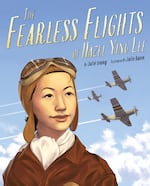There aren’t too many historical photos of Portland-born Hazel Ying Lee, but of the ones you can find online, there’s an unmistakable look of self-determination and courage emanating from her. Those are two traits that undeniably helped her overcome racism and gender discrimination to become the first Chinese-American woman to fly for the U.S. military during World War II. A new children’s book called “The Fearless Flights of Hazel Ying Lee” chronicles her incredible story.
OPB’s All Things Considered Host Tiffany Camhi spoke with the author of the book Julie Leung about the legacy Lee left behind.
Tiffany Camhi: Lee was born into a large Chinese American family in Portland in 1912. What was life like for people of Asian descent in Oregon at that time?
Julie Leung: In my research for this book, a lot of the experiences that I read about were very much reflective of the oppressiveness of the Chinese Exclusion Act. That was the first federal law enacted to ban an entire ethnicity group from immigrating to the U.S. So Chinese Americans who are already here in the United States became very isolated in their own Chinatowns. They had curfews that they had to abide by. They weren’t considered U.S. citizens. In fact, they did not have citizenship. So Hazel [grew] up in that atmosphere. I think, even though she was a child, she obviously realized that there were these invisible walls around her growing up in Portland. I can’t imagine that she did not feel these barriers in her day-to-day life.
Camhi: So Hazel had to overcome all of that discrimination yet she still learned how to fly planes. And then eventually she joined a team of elite women pilots in the U.S. Air Force. How did she do all that?
Leung: I just think singular determination. One of the things that has always struck me in every photo of Hazel that I ever came across is just this boldness in her eyes. She just wanted to do something that no other Chinese American girl had done before. In the book, she tags along on this fun trip with a friend and the minute she hits the air she just realized this is what she wanted to do no matter what. So Hazel did everything that she could to pay for flying lessons. She earned her license in a little over a year and from then on she just did not stop pursuing the skies.
When the Japanese invaded China in the early 1930s as part of World War II, she actually went back to China to try to enlist in the Chinese Air Force. They wouldn’t let her fly so she eventually came back to the United States. When the Women Airforce Service Pilots program opened up, the first thing she did was enlist.
Every anecdote I’ve ever read about Hazel describes what a bold and bright personality she was. She would use her lipstick and write out Chinese nicknames on the tail of her peer’s planes. So you get this wonderful, vibrant portrait of a woman ahead of her time and who used her ethnicity as a point of pride.
Camhi: Why did you choose to tell her story through a children’s book?
Leung: I think about when I was younger and the picture books that I truly wanted to see, which were people who looked like me living in this country and doing great things. Those weren’t necessarily available to me. Part of what really drives me to write picture books about Asian Americans is this hope that for the next generation these books are available, particularly books about Asian American women who fight stereotypes. Hazel stood out to me as a perfect example of that. I thought she deserved a place in the storybooks.

Author Julie Leung says she chose to write about Hazel Ying Lee because she wanted to see more children's books that center strong Asian American women
Illustration by Julie Kwon. Courtesy of Little, Brown Books for Young Readers
Camhi: You mention Lee’s Cantonese heritage several times in the book. Why did you decide to add that?
Leung: It was very important to me to acknowledge the multitudes of cultures that exist within the Chinese diaspora. The majority of [Chinese] immigrants coming to the United States before the 1960s came from the Guangdong province. I wanted to differentiate the Cantonese aspects of that culture, like the phrases and the pronunciations. I wanted to honor that, if only to make sure that the world understands that it’s not a monolith. The Chinese language has many different dialects and it’s not all just Mandarin.
Camhi: How does it feel to have this book come out now, at a time when hate crimes against Asian Americans and Pacific Islanders are alarmingly high?
Leung: I wrote this book two years ago. I wrote it with this idea of writing for myself, for the version of myself that would exist now. And I think having the book come out during this climate has made me realize that this book isn’t just for the community that I identify with. It should be for everyone to read. It’s important that there are multiple narratives out in the world for other people to experience.
Hear the full conversation in the audio player above.
